四年级下册湘教版英语 (3)
- 格式:ppt
- 大小:1.61 MB
- 文档页数:3

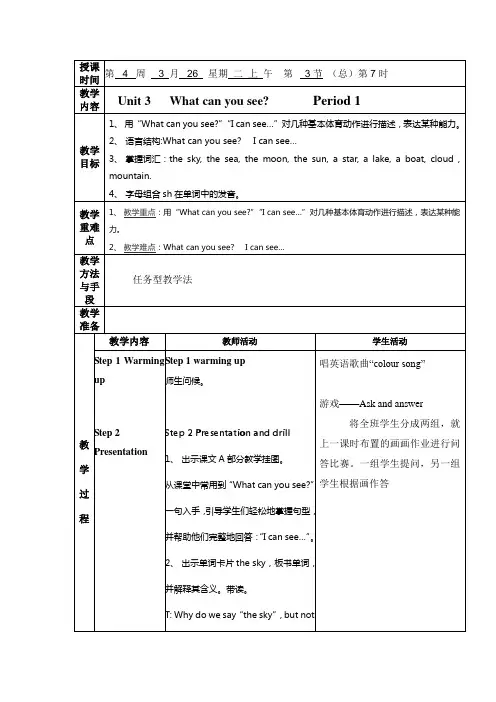

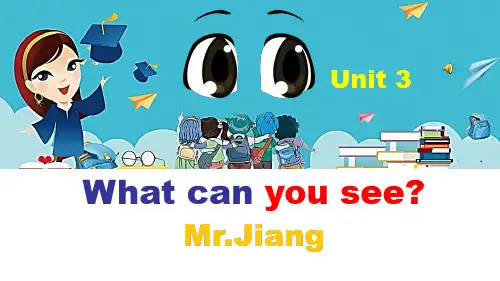
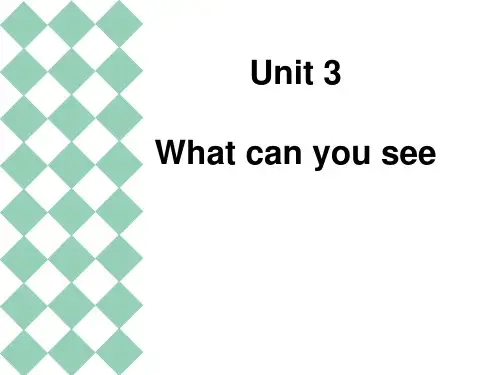
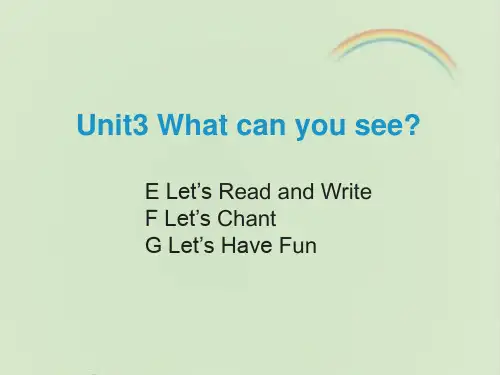
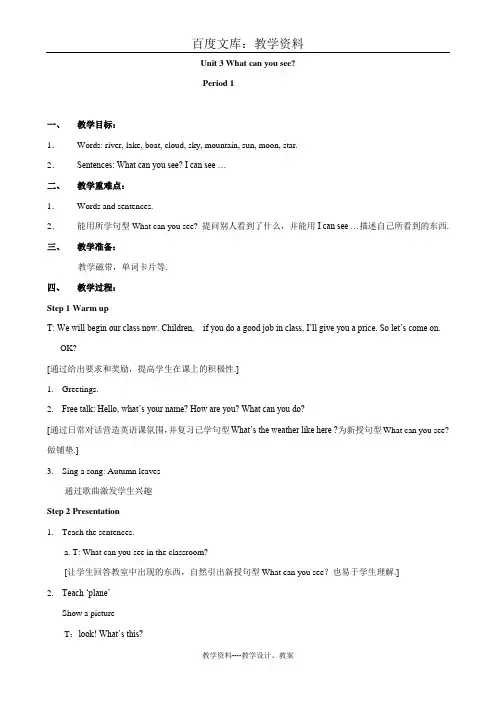
Unit 3 What can you see?Period 1一、教学目标:1.Words: river, lake, boat, cloud, sky, mountain, sun, moon, star.2.Sentences: What can you see? I can see …二、教学重难点:1.Words and sentences.2.能用所学句型What can you see? 提问别人看到了什么,并能用I can see …描述自己所看到的东西.三、教学准备:教学磁带,单词卡片等.四、教学过程:Step 1 Warm upT: We will begin our class now. Children, if you do a good job in class, I’ll give you a price. So let’s come on.OK?[通过给出要求和奖励,提高学生在课上的积极性.]1.Greetings.2.Free talk: Hello, what’s your name? How are you? What can you do?[通过日常对话营造英语课氛围,并复习已学句型What’s the weather like here ?为新授句型What can you see?做铺垫.]3.Sing a song: Autumn leaves通过歌曲激发学生兴趣Step 2 Presentation1.Teach the sentences.a. T: What can you see in the classroom?[让学生回答教室中出现的东西,自然引出新授句型What can you see?也易于学生理解.]2.Teach ‘plane’Show a pictureT:look! What’s this?S:(提示学生)plane通过开火车等小游戏巩固单词3.Teach ‘boat’Show a pictureT: Look, here’s a picture. What can you see in the sky? (plane, kite) What can you see in the river? (duck, boat)[把单词和句型结合在一起操练学习,并为新单词的引出做了铺垫.]T: Oh, how to read this word? Can you read this word? (coat—boat)T: 现在让我们模仿小动物的声音来读这些单词T: Read the word as a cat….T: Here’re some boats. Let’s learn how to read them. (duck boat, sail boat, dragon boat)[让学生通过已学单词自己说出新授单词的发音,并通过模仿不同小动物的声音来操练新单词,增加他们的兴趣.再进行单词的拓展训练.]4.What can you see in the sky?(the moon, the sun, star, cloud)Show a pictureT: look this picture, What can you see? (the sun, the moon, star, cloud)…以同样方式教授新单词Step 3 practiceT: Now, let’s play a game ‘listen and guess’Can you make sentences with the word? For example: I can see the sun.[通过听声音猜单词的方式来学习新单词,学生比较感兴趣.而且让学生再进行造句的练习,把单词和句型结合在了一起.]Period 2一、教学目标能更进一步掌握新单词;能熟练地运用本课文描述自己身边的物品和风景;能阅读并理解课文D部分.二、教学重点及难点重点:掌握新单词;难点: 阅读理解课文D部分.三、教学准备图片、教学磁带等.四、教学步骤Step 1 Warming up师生问候.自由练习课文A部分对话,挑选一两组上台表演.Step 2 Presentation and drill教学过程T:Class is begin .(上课.)M: Stand up, please.(起立.)T: Good morning, class.(同学们,早上好.)S: Good morning, teacher.(老师,早上好.)M: Sit down, please.(坐下.)一、听儿歌,导入课题.(What can you see?)T:请同学们听儿歌,并出示图片,说一说,你看到了什么?指名学生回答.(You say.你来说说.)S: sun(太阳)tree(树)Plane(飞机)…“你看到了什么”用英语怎么说呢?(生:What can you see?)Step 3 Practice课文D部分.阅读故事,理解大意,标出难以理解的地方.教师解释说明一些难点.分小组练读.分角色表演Step 4 Consolidation家庭作业.听磁带,背课文,记单词.Period 3一、教学目标能掌握字母组合ch在单词中的发音,并能理解和读出新单词;能读出由含有字母组合ch的单词组成的句子;能诵读英语小歌谣;培养学生学习英语的兴趣,同时规范、训练口语.二、教学重点与难点重点:字母组合ch在单词中的发音;诵读英语小歌谣.难点:理解新单词;朗读句子.三、教学准备教学磁带等.Step 1 Warming up师生问候.自由谈论身边的所见所闻.(先自由练习,然后挑选一两组上台表演.)Step 2 Presentation and drill课文E部分学生先自读短文,把不理解的单词划出来.教师讲解疑问.学生完成短文后的题目.教师抽查并讲解.Step 3 Practice课文F部分歌谣.听录音,跟读.配上动作,有感情地朗诵.集体或单个背诵.分组练习.(可组织个人或小组诵读比赛)课文G部分教师提示,学生自主填空教师抽学生回答并讲解.Step 4 Consolidation家庭作业听磁带,读课文.默读课文B部分单词.背诵课文A B C 部分.课后反思:。

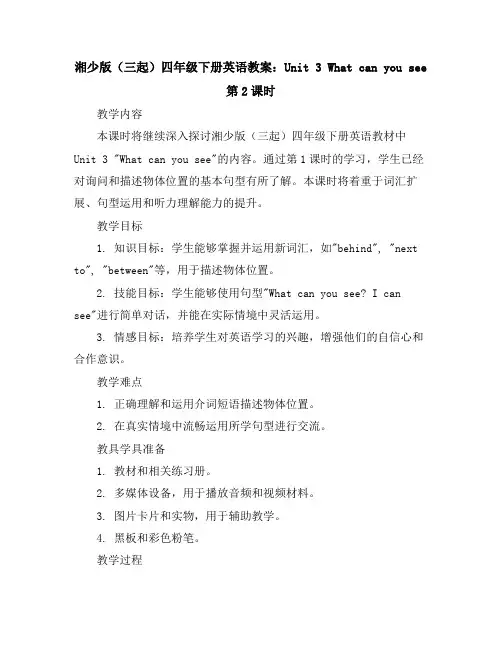
湘少版(三起)四年级下册英语教案:Unit 3 What can you see第2课时教学内容本课时将继续深入探讨湘少版(三起)四年级下册英语教材中Unit 3 "What can you see"的内容。
通过第1课时的学习,学生已经对询问和描述物体位置的基本句型有所了解。
本课时将着重于词汇扩展、句型运用和听力理解能力的提升。
教学目标1. 知识目标:学生能够掌握并运用新词汇,如"behind", "next to", "between"等,用于描述物体位置。
2. 技能目标:学生能够使用句型"What can you see? I can see"进行简单对话,并能在实际情境中灵活运用。
3. 情感目标:培养学生对英语学习的兴趣,增强他们的自信心和合作意识。
教学难点1. 正确理解和运用介词短语描述物体位置。
2. 在真实情境中流畅运用所学句型进行交流。
教具学具准备1. 教材和相关练习册。
2. 多媒体设备,用于播放音频和视频材料。
3. 图片卡片和实物,用于辅助教学。
4. 黑板和彩色粉笔。
教学过程1. 课堂导入:通过复习第1课时的内容,快速激活学生的相关知识。
2. 新知呈现:借助图片和实物,介绍新词汇和句型。
3. 实践练习:通过小组活动,让学生练习使用新词汇和句型。
4. 听力训练:播放相关音频,让学生听并理解对话内容。
5. 角色扮演:学生分角色扮演,模拟真实情境进行对话。
板书设计1. 新词汇和短语:用彩色粉笔突出显示。
2. 句型结构:用图表或流程图形式展示。
3. 关键语法点:用例句和解释性文字说明。
作业设计1. 完成练习册中与本课时相关的练习题。
2. 家长协助,用英语描述家中物品的位置,记录下来。
3. 小组合作,编排一个简短对话,使用本课时学到的句型和词汇。
课后反思本课时结束后,教师应反思教学内容是否恰当,教学方法是否有效,以及学生的学习效果如何。
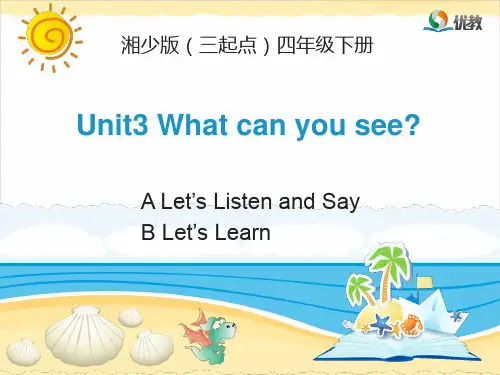

湘教版四年级下册第三单元第一课时教学设计
the sun 太阳
the moon 月亮
cloud 白云
star 星星
为什么太阳和月亮前面要加the 呢?
因为太阳和月亮都是独一无二的,所以前面要加the.
What can you see?我们可以回答I can see the sun.
如果你看到月亮。
你要怎么回答呢?
在海上我们需要什么交通工具呢?对了就是“船”Read after me.boat boat小船
What can you see? 用boat 回答。
同学们,有水的地方除了大海,还有湖和河流,你知道它们的英语怎么说吗?
Read after me .lake lake 湖
river river 河流
最后一个单词是大山
Read after me.
mountain,mountain大山
好,让我们跟着视频一起读读这些单词吧!
现在让我们一起做一个游戏
Fill.
根据规律填写缺少的单词,或者图片的对应单词。
湘少版(三起)四年级下册英语教案:Unit 3 What can you see第1课时教学内容本节课为湘少版(三起)四年级下册英语第3单元第1课时,主题为"What can you see"。
教学内容围绕日常生活中的视觉体验展开,通过描述在不同场景下能看到的事物,教授学生相关的英语表达。
课程内容包括词汇学习、句型练习、听力训练和口语对话。
教学目标1. 知识目标:学生能够掌握本单元的关键词汇,如"sky", "cloud", "bird", "plane"等,并能运用句型"What can you see? I can see"进行基本对话。
2. 能力目标:培养学生观察周围环境并用英语描述的能力,提高学生的听说技能。
3. 情感目标:激发学生对英语学习的兴趣,鼓励学生积极参与课堂活动。
教学难点1. 词汇记忆:本单元涉及的词汇较多,学生可能难以记忆。
2. 句型应用:正确使用"What can you see? I can see"句型进行问答。
3. 听力理解:理解不同场景下的英语描述。
教具学具准备1. 教材:湘少版(三起)四年级下册英语教科书。
2. 多媒体:PPT课件,包含图片、音频和视频材料。
3. 实物教具:与教学内容相关的图片或模型。
4. 学具:学生每人一本教科书,练习本和笔。
教学过程1. 课堂导入:通过展示相关图片,引导学生谈论他们在图片中能看到什么。
2. 新知呈现:教授本单元的关键词汇和句型,使用PPT和实物教具辅助教学。
3. 练习活动:进行听力练习和角色扮演,加强学生对新知识的理解和应用。
4. 巩固环节:通过小组活动,让学生运用所学知识进行对话。
板书设计板书将包括本单元的关键词汇、句型和重要语法点。
通过清晰的布局和色彩区分,帮助学生更好地理解和记忆。
作业设计1. 书面作业:完成教科书上的相关练习题。
4年级下册英语湘少版第3课中文The 3rd lesson of the 4th grade English textbook in the Xiangshao Edition focuses on introducing students to different types of animals and their habitats. In this lesson, students will learn new vocabulary related to animals, practice using the present simple tense to talk about animals, and develop their listening and speaking skills through various activities.The lesson starts with a warm-up activity where students are shown pictures of different animals and asked to identify them. This helps students review previously learned vocabulary and get them thinking about the topic of the lesson. The teacher then introduces new vocabulary words such as "habitat," "jungle," "forest," "desert," and "arctic" to help students describe where animals live.After learning the new vocabulary, students engage in a listening activity where they listen to descriptions of different animals and match them to their habitats. This activity not only helps students practice their listening skills but also reinforces the new vocabulary they have just learned. Following the listening activity, students participate in a speaking task where they take turns describing an animal to their classmates and guessing where it lives based on the description.To further reinforce the vocabulary and grammar structures introduced in the lesson, students work on a series of exercises in their textbooks. These exercises include matching animals to their habitats, completing sentences using the present simple tense, and writing short paragraphs describing their favorite animals and where they live. Through these activities, students get more practice using the new vocabulary and grammar structures in context.In addition to the textbook activities, teachers can also incorporate games, songs, and role-playing activities to make the lesson more engaging and interactive. For example, teachers can organize a safari-themed scavenger hunt where students have to find and identify different animals around the classroom or school. They can also sing songs about animals and their habitats or role-play being zookeepers taking care of different animals.Overall, the 3rd lesson of the 4th grade English textbook in the Xiangshao Edition provides students with a fun and interactive way to learn about animals and their habitats. By introducing new vocabulary, practicing grammar structures, and engaging in various activities, students can develop their Englishlanguage skills while also expanding their knowledge of the natural world.。